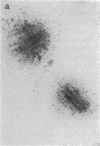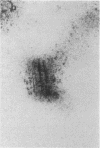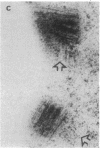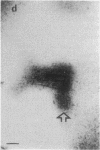Abstract
Heterologous centrosomes from diversed species including humans promote egg cleavage when injected into metaphase-arrested Xenopus eggs. We have recently isolated centrosomes from calf thymocytes and shown that they were unable to induce egg cleavage, an inability that was apparently correlated with the peculiar structure of these centrosomes rather than with a lack of microtubule-nucleating activity: the two centrioles were associated in a colinear orientation by their proximal ends. To promote cleavage, a heterologous centrosome probably is required to duplicate, although this has not yet been demonstrated. Therefore, we designed an in vitro assay that would enable us to directly observe the duplication process. We show that competent centrosomes from KE37 cells synchronized in G1 phase initiate procentriole budding in interphasic extracts from Xenopus eggs in the absence of protein synthesis, whereas calf thymocyte centrosomes do not. Since calf thymocyte centrosomes do not support parthenogenesis, the present results suggest that duplication of the foreign centrosome is required for centrosome-induced parthenogenesis. Furthermore, procentriole budding takes place in the absence of protein synthesis in egg extracts arrested in S phase. This in vitro assay should contribute to the identification of molecular mechanisms involved in the initiation of centrosome duplication.
Full text
PDF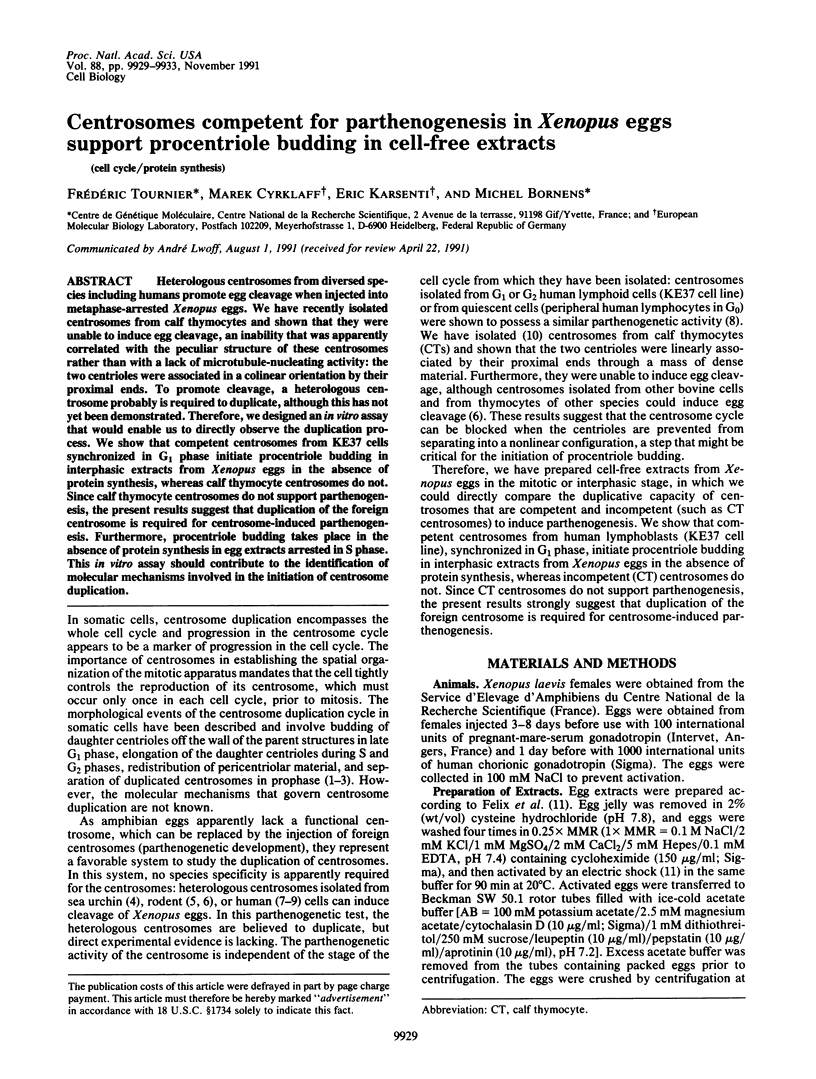
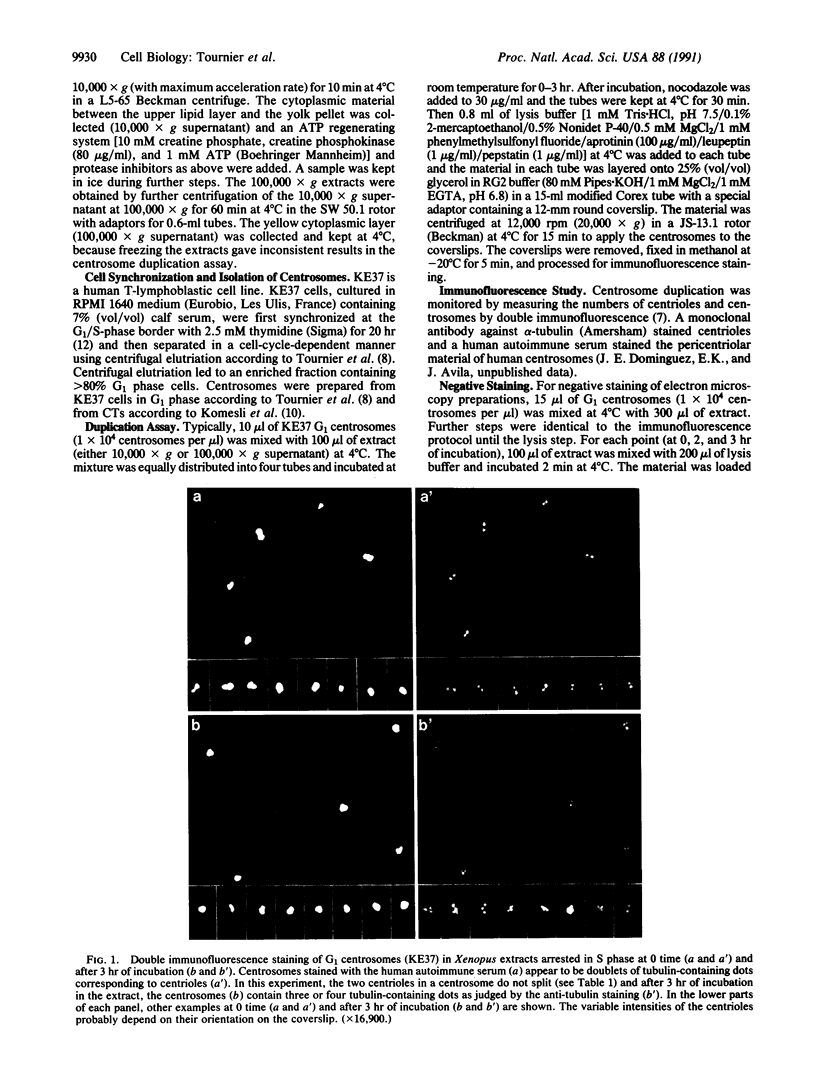
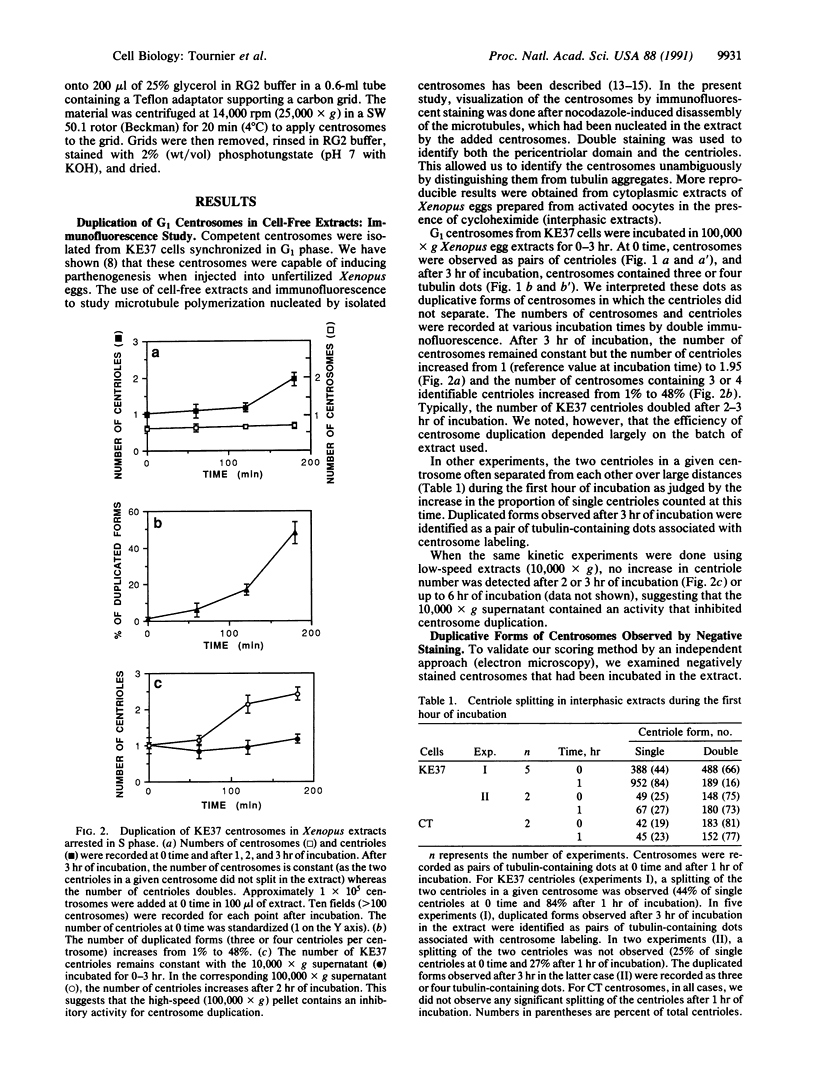
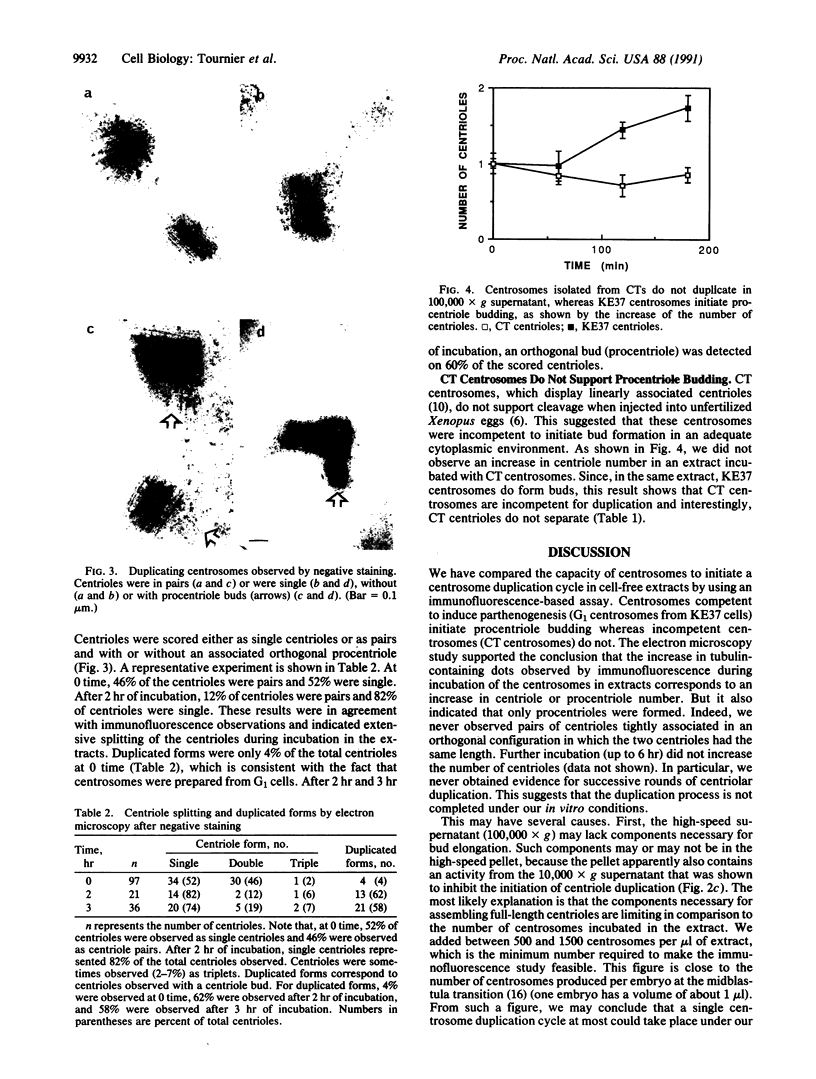
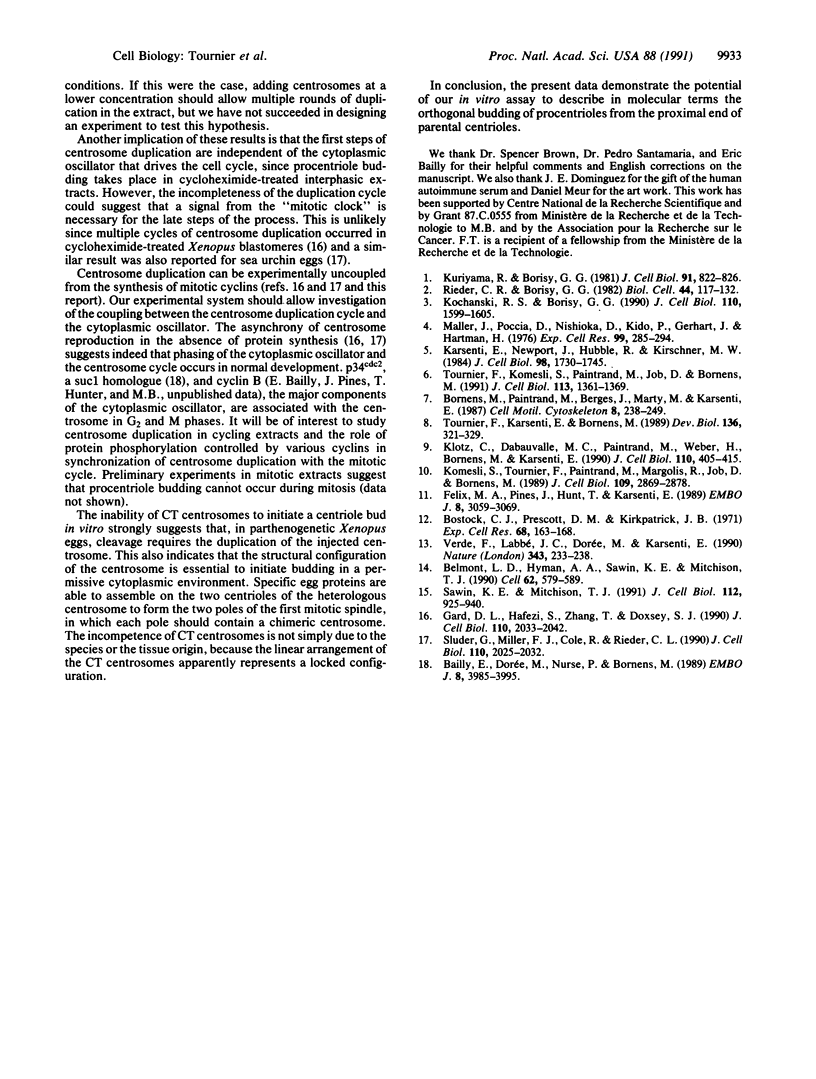
Images in this article
Selected References
These references are in PubMed. This may not be the complete list of references from this article.
- Bailly E., Dorée M., Nurse P., Bornens M. p34cdc2 is located in both nucleus and cytoplasm; part is centrosomally associated at G2/M and enters vesicles at anaphase. EMBO J. 1989 Dec 20;8(13):3985–3995. doi: 10.1002/j.1460-2075.1989.tb08581.x. [DOI] [PMC free article] [PubMed] [Google Scholar]
- Belmont L. D., Hyman A. A., Sawin K. E., Mitchison T. J. Real-time visualization of cell cycle-dependent changes in microtubule dynamics in cytoplasmic extracts. Cell. 1990 Aug 10;62(3):579–589. doi: 10.1016/0092-8674(90)90022-7. [DOI] [PubMed] [Google Scholar]
- Bornens M., Paintrand M., Berges J., Marty M. C., Karsenti E. Structural and chemical characterization of isolated centrosomes. Cell Motil Cytoskeleton. 1987;8(3):238–249. doi: 10.1002/cm.970080305. [DOI] [PubMed] [Google Scholar]
- Bostock C. J., Prescott D. M., Kirkpatrick J. B. An evaluation of the double thymidine block for synchronizing mammalian cells at the G1-S border. Exp Cell Res. 1971 Sep;68(1):163–168. doi: 10.1016/0014-4827(71)90599-4. [DOI] [PubMed] [Google Scholar]
- Felix M. A., Pines J., Hunt T., Karsenti E. A post-ribosomal supernatant from activated Xenopus eggs that displays post-translationally regulated oscillation of its cdc2+ mitotic kinase activity. EMBO J. 1989 Oct;8(10):3059–3069. doi: 10.1002/j.1460-2075.1989.tb08457.x. [DOI] [PMC free article] [PubMed] [Google Scholar]
- Gard D. L., Hafezi S., Zhang T., Doxsey S. J. Centrosome duplication continues in cycloheximide-treated Xenopus blastulae in the absence of a detectable cell cycle. J Cell Biol. 1990 Jun;110(6):2033–2042. doi: 10.1083/jcb.110.6.2033. [DOI] [PMC free article] [PubMed] [Google Scholar]
- Karsenti E., Newport J., Hubble R., Kirschner M. Interconversion of metaphase and interphase microtubule arrays, as studied by the injection of centrosomes and nuclei into Xenopus eggs. J Cell Biol. 1984 May;98(5):1730–1745. doi: 10.1083/jcb.98.5.1730. [DOI] [PMC free article] [PubMed] [Google Scholar]
- Klotz C., Dabauvalle M. C., Paintrand M., Weber T., Bornens M., Karsenti E. Parthenogenesis in Xenopus eggs requires centrosomal integrity. J Cell Biol. 1990 Feb;110(2):405–415. doi: 10.1083/jcb.110.2.405. [DOI] [PMC free article] [PubMed] [Google Scholar]
- Kochanski R. S., Borisy G. G. Mode of centriole duplication and distribution. J Cell Biol. 1990 May;110(5):1599–1605. doi: 10.1083/jcb.110.5.1599. [DOI] [PMC free article] [PubMed] [Google Scholar]
- Komesli S., Tournier F., Paintrand M., Margolis R. L., Job D., Bornens M. Mass isolation of calf thymus centrosomes: identification of a specific configuration. J Cell Biol. 1989 Dec;109(6 Pt 1):2869–2878. doi: 10.1083/jcb.109.6.2869. [DOI] [PMC free article] [PubMed] [Google Scholar]
- Kuriyama R., Borisy G. G. Microtubule-nucleating activity of centrosomes in Chinese hamster ovary cells is independent of the centriole cycle but coupled to the mitotic cycle. J Cell Biol. 1981 Dec;91(3 Pt 1):822–826. doi: 10.1083/jcb.91.3.822. [DOI] [PMC free article] [PubMed] [Google Scholar]
- Maller J., Poccia D., Nishioka D., Kidd P., Gerhart J., Hartman H. Spindle formation and cleavage in Xenopus eggs injected with centriole-containing fractions from sperm. Exp Cell Res. 1976 May;99(2):285–294. doi: 10.1016/0014-4827(76)90585-1. [DOI] [PubMed] [Google Scholar]
- Sawin K. E., Mitchison T. J. Mitotic spindle assembly by two different pathways in vitro. J Cell Biol. 1991 Mar;112(5):925–940. doi: 10.1083/jcb.112.5.925. [DOI] [PMC free article] [PubMed] [Google Scholar]
- Sluder G., Miller F. J., Cole R., Rieder C. L. Protein synthesis and the cell cycle: centrosome reproduction in sea urchin eggs is not under translational control. J Cell Biol. 1990 Jun;110(6):2025–2032. doi: 10.1083/jcb.110.6.2025. [DOI] [PMC free article] [PubMed] [Google Scholar]
- Tournier F., Karsenti E., Bornens M. Parthenogenesis in Xenopus eggs injected with centrosomes from synchronized human lymphoid cells. Dev Biol. 1989 Dec;136(2):321–329. doi: 10.1016/0012-1606(89)90259-5. [DOI] [PubMed] [Google Scholar]
- Tournier F., Komesli S., Paintrand M., Job D., Bornens M. The intercentriolar linkage is critical for the ability of heterologous centrosomes to induce parthenogenesis in Xenopus. J Cell Biol. 1991 Jun;113(6):1361–1369. doi: 10.1083/jcb.113.6.1361. [DOI] [PMC free article] [PubMed] [Google Scholar]
- Verde F., Labbé J. C., Dorée M., Karsenti E. Regulation of microtubule dynamics by cdc2 protein kinase in cell-free extracts of Xenopus eggs. Nature. 1990 Jan 18;343(6255):233–238. doi: 10.1038/343233a0. [DOI] [PubMed] [Google Scholar]




